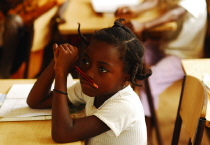
Typical street scene in Santa Ana, El Salvador. (Photo: iStock)
IMF Survey: IMF Steps Up Analysis of Risks for Low-Income Countries
September 21, 2011
- Commodity price volatility increases vulnerability of low-income countries
- IMF’s new analytical tool helps poor countries anticipate impact of price surges, falls
- Targeted subsidies needed to shield the most fragile groups, says IMF
With advanced economies under pressure, the IMF is stepping up its analysis of risks spreading to low-income countries.

School feeding programs are one way to protect most vulnerable from effects of commodity price volatility (photo: Anthony Aseal/Art in All of Us/Corbis)
IMF-WORLD BANK ANNUAL MEETINGS
The possible dangers confronting some of the poorest countries in the world were outlined at a high-level seminar on “Commodity Price Volatility and Inclusive Growth in Low-Income Countries,” taking place as part of the annual IMF-World Bank meetings. The seminar was opened by IMF Managing Director Christine Lagarde, who said the capacity of many low-income countries to absorb further shocks had yet to be rebuilt from the past two crises.
In an interview with IMF Survey online, Hugh Bredenkamp of the IMF’s Strategy, Policy, and Review Department explained some of the threats facing low-income countries, which in recent years have been buffeted by volatile commodity prices.
IMF Survey online: How are low-income countries impacted by sudden changes in commodity prices?
Bredenkamp: Commodity prices tend to move around very wildly as we have seen in particular, in the last five years. It can be a problem both on the upside and on the downside. When you get surges in prices, for some countries, they create big windfalls which lead to spending pressures. Governments are tempted to ratchet up spending and give out pay rises to everybody.
So, when the prices drop again, it is very difficult for them to unwind that spending, so they get into difficulties.
IMF Survey online: The International Monetary Fund recently developed a new way to assess the vulnerability of poor countries to external shocks. Can you tell us more about the Vulnerability Exercise for Low-Income Countries?
Bredenkamp: This is a new set of analytical tools that we have put together to try to assess the linkages between different kinds of shocks—whether it is to commodity prices or to global growth—and their impact on low-income countries. We have been doing this kind of exercise for some years for the more advanced economies, trying to assess the risk of a capital account crisis, meaning the outflow of capital that causes a financing crisis. For low-income countries, this risk is less prominent given the nature of their economies.
The big threat for a poor country is that its growth will suddenly drop sharply. These tools allow us to estimate the probability of that very bad event happening and its likely impact on that country.
IMF Survey online: What are your findings?
Bredenkamp: In our first real exercise in putting this framework through its paces, we looked at two major risks. One is that the global economy will go into another sharp downturn: the risk that we’re most concerned about.
But if you look a bit further ahead, even if the growth in the global economy stumbles now, it will recover at some point. At that point, we risk seeing another surge in commodity prices.
One thing that comes out clearly from this analysis is, first of all, the size of the impact that a commodity price shock could have. It could double inflation rates in an average low-income country.
Secondly, because we are just coming out of one global crisis where countries had to use up some of their ammunition to defend themselves against that crisis —spending more when revenues were declining and running down some of their reserve—they now have less ammunition when another shock hits. That is our concern.
IMF Survey Online: What can low-income countries do to build a buffer against potential commodity swings or another recession?
Bredenkamp: Although it is very inefficient and costly to provide subsidies, you can provide subsidies if you target specific products—fuel products, for example—that you know are consumed mostly by the poor. For example, in Senegal, they subsidize kerosene which is used mostly by the poor for cooking.
In effect, most of the subsidies do indeed go to the people who need it. That is, the lowest income groups. One can indirectly target these groups in that manner. In the case of food price shocks, you can provide subsidies for agricultural inputs. In Malawi, they provided fertilizer subsidies. You can also link basic social services. For example, in Sierra Leone, they provide school-based feeding programs. In Ghana and Kenya, the households would get payments conditional on their kids attending school and other related conditions.
So there are these kinds of ad hoc mechanisms which are not perfect, but which keep down the costs and help target support to the people who need it.
IMF Survey online: Looking at the information that you’ve gathered from the Vulnerability Exercise for Low-Income Countries, how are you feeling about the future of low-income countries going forward?
Bredenkamp: The future of these countries is tied quite closely to the future of the global economy. So, at the moment, our main concern at the IMF is that the global economy does not take a serious turn for the worse.
Most of the action that is needed to bring that good scenario about has to be taken by the rich economies. We are hopeful that they will take the necessary steps.
If they do, there is no reason why the kinds of growth we have seen for the last couple of years, but that we also saw for almost a decade in the run-up to the 2008 crisis, should not come back. Given the progress that has been made, we are optimistic.







